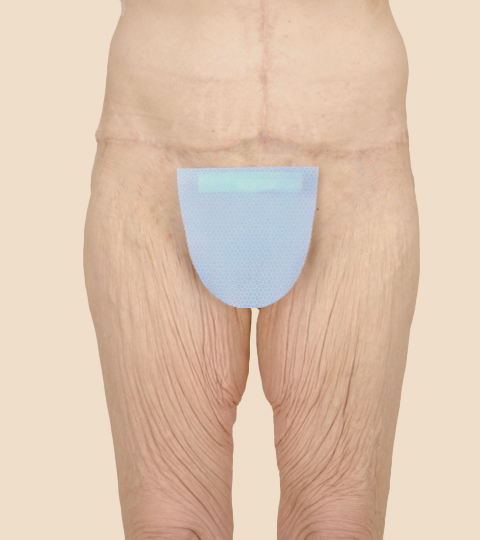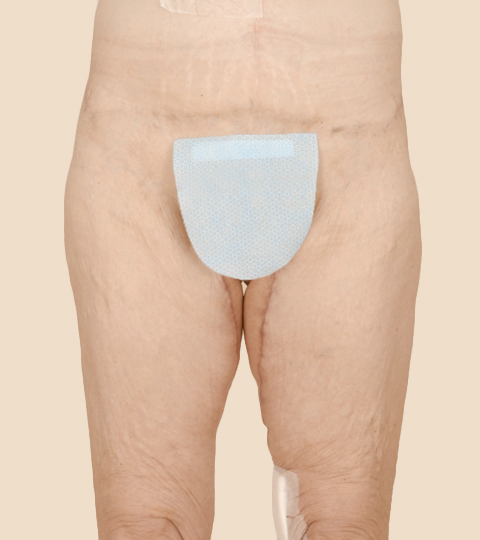Overview
What is body contouring surgery after significant weight loss?
Losing a large amount of weight is a major achievement. But once you’ve reached your goal, you might find that your new, thinner body needs some additional fine-tuning. That’s because large amounts of excess skin that have been stretched around your abdomen, arms, legs, breasts and face may have lost their elasticity. After significant weight loss, the skin often fails to shrink back to its former size and shape.
Plastic surgeons at Cleveland Clinic’s Cosmetic & Plastic Surgery Center offer excess skin removal (body contouring) surgeries designed specifically for patients who’ve achieved significant weight loss. Procedures that remove skin or fat, tighten and lift can be used as a complement to help your clothes fit better and allow you to participate more comfortably in your favorite activities.
Why choose us?
When considering surgery after significant weight loss, choose a surgeon with significant experience performing the procedure. Friends, family members or an internist or primary care provider are often helpful in suggesting the best surgeon.
For the best results, choose a cosmetic surgeon who’s affiliated with a major medical center, such as Cleveland Clinic. Make sure to ask your cosmetic surgeon about their credentials, training and how many procedures they’ve performed.
Learn more about Cleveland Clinic Cosmetic & Plastic Surgery Center.
How to Prepare
Am I a candidate for surgery after significant weight loss?
The best way to determine if you’re a candidate for excess skin removal (body contouring) surgery after significant weight loss is through a thorough consultation with a plastic surgeon at Cleveland Clinic Cosmetic & Plastic Surgery Center.
The most successful outcomes from body contouring surgery are achieved when these important criteria are met:
Weight trend
Has your weight been stable for at least a year with no further weight loss expected?
Overall good health
Are you in good health overall? Do you have any chronic medical conditions, such as diabetes or high blood pressure? People in poor health aren’t good candidates for body contouring procedures. You should carefully review your health with a provider at Cleveland Clinic Cosmetic & Plastic Surgery Center before proceeding with surgery.
Nutrition
Do you have a well-balanced diet? A large amount of weight loss can lead to anemia, vitamin deficiencies and other problems. So, before surgery, your physician will screen to rule out these conditions.
Smoking history
Smoking slows down the healing process and increases the risk of serious complications during and after surgery. You’ll be instructed to quit smoking at least six weeks before surgery.
People with a positive outlook and realistic goals for what body contouring can accomplish are also good candidates.
How do I prepare for excess skin removal (body contouring) surgery after significant weight loss?
Preparing for surgery after significant weight loss at Cleveland Clinic Cosmetic & Plastic Surgery Center includes discussing a number of questions about your health, desires and lifestyle with your plastic surgeon, including:
- Why you want the treatment(s), your expectations and desired outcome.
- A discussion of your overall medical health, medical history, medications and use of alcohol and tobacco products.
Your Cleveland Clinic plastic surgeon will also:
- Take photos of your body for your medical record.
- Discuss your body contouring treatment options.
- Discuss likely expected outcomes of body contouring treatment and risks or potential complications.
What to Expect
How is surgery after significant weight loss performed?
There are a variety of body contouring procedures that can treat your needs after significant weight loss. Your plastic surgeon will work with you to identify areas that are the most problematic or bothersome to you.
The areas of the body that are most often treated through body contouring after significant weight loss include:
Abdomen
Also known as a “tummy tuck,” abdominoplasty involves removing excess skin and tightening the underlying abdominal muscles. A surgeon makes an incision just above the pubic area from hip to hip, occasionally extending to the back. Sometimes, a vertical incision is necessary if there’s a large amount of skin excess in the horizontal direction.
A panniculectomy only removes skin overhanging the pubis and doesn’t address skin above your belly button. Having your abdominal muscles tightened or extending the incision to the back is most often considered cosmetic and isn’t usually covered by insurance.
At times, an abdominal hernia may be found. Hernias up to a certain size can be repaired at the time of the removal of excess abdominal skin. However, your plastic surgeon may refer you to a general surgeon if the hernia is too large to be repaired during the abdominal procedure.
Buttocks/upper thighs
A body lift, or belt lipectomy, is a procedure to remove skin and lift your thighs and buttock. A surgeon usually performs this procedure as a continuation of an abdominal procedure with the incision extended completely around the back. They make the incision in the belt area in the upper hips and remove excess skin below the incision.
Thighs
A medial thigh lift, designed to remove excess skin from your upper leg, involves an incision along the inner thigh starting at the groin and extending as far as the knee.
Breasts
A number of breast procedures are available, including breast lift with or without augmentation (enlargement with implants) and breast reduction. To lift the drooping breast, a surgeon lifts and positions the nipples in a more typical position. This procedure requires significant incisions, including an incision around the nipple (vertical down the breast and horizontally under the breast fold).
Arms
During surgery to remove excess skin from your arms (brachioplasty), a surgeon makes an incision starting at the armpit and extending to the elbow. Sometimes, the incision extends onto the chest and can be combined with a breast procedure.
Face & neck
Removing excess skin around the face or neck after weight loss is similar to a traditional facelift. However, the incisions may need to be somewhat longer behind the ear and along the hairline.
A combination of body contouring surgeries may be done at the same time, as long as it’s safe to do so. An “upper body lift” may include a combination of surgeries to the arms, back and breasts/chest.
A “lower body lift” may include a combination of surgeries to your hips, thighs, abdomen and buttock. The exact procedures to be performed at one time will be individualized to your needs through a thorough consultation with a plastic surgeon at Cleveland Clinic Cosmetic & Plastic Surgery Center.
Results
What results can I expect?
The results of body contouring surgery after significant weight loss are visible almost immediately. If you’ll be having several procedures, they may be done in stages rather than all at one time. This approach allows for touch-ups if more skin needs to be removed from an earlier procedure. Visible scars from surgery will remain, but the overall results are long lasting if you maintain a stable weight and good fitness.
As your body ages, it’s natural to lose some firmness. However, most of your initial improvement should be relatively permanent. Following up with an expert at Cleveland Clinic Cosmetic & Plastic Surgery Center is the best way to ensure long-lasting results from your body contouring procedures. View our before and after photos to see results from actual patients.
What is involved in recovery?
Following your body contouring procedure(s) after significant weight loss, dressings or bandages will be applied to the incisions. You may have a small, thin tube (drain) temporarily placed under your skin to drain any excess blood or fluid that might collect. The number of drains used may vary depending on the procedure.
Body contouring surgeries may be performed in an outpatient setting or require an overnight stay (or more) depending on the procedure. Your post-surgery activities will be restricted until you’ve had plenty of time to recover. Restrictions may include no exercise and lifting of 5 pounds or more. Walking is encouraged after surgery; however, additional exercise isn’t recommended until you’ve fully healed.
A certain degree of soreness, swelling and bruising for two to three weeks after surgery is normal. Most people can return to work after two to four weeks, but people with physically demanding jobs need to wait at least three weeks. During this recovery period, you’ll be monitored regularly by your plastic surgeon to ensure the best results.
Is surgery after significant weight loss safe?
Possible risks of body contouring surgery after significant weight loss include:
- Unfavorable scarring.
- Bleeding (hematoma).
- Infection.
- Fluid accumulation.
- Poor wound healing.
- Skin loss.
- Numbness or other changes in skin sensation.
- Anesthesia risks.
- Skin discoloration and/or prolonged swelling.
- Fatty tissue found deep in the skin might die (fat necrosis).
- Major wound separation.
- Asymmetry.
- Recurrent looseness of skin.
- Pain, which may persist.
- Deep vein thrombosis, cardiac and pulmonary complications.
- Persistent swelling in the legs.
- Possibility of revisional surgery.
Insurance & Financing
Insurance rarely covers the cost of elective cosmetic surgery and procedures. Please call 216.444.4004 and ask to speak with one of our financial representatives who can explain payment options, including CareCredit financing.




